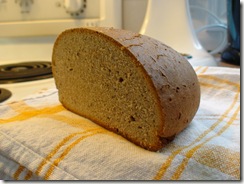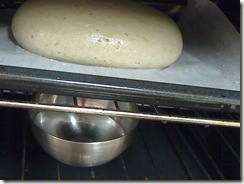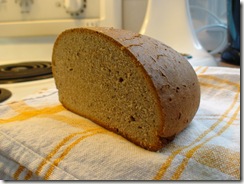I can’t and I will not speak for everyone and on general level, but I have to confess that the first what my Czech taste buds abroad was craving for was Czech traditional bread with caraway seeds… In some bakeries (esp. in big cities) you can buy Swiss, German or Austrian versions of traditional European bread. No doubt this kind of breads are quite tasty, but the flavour is not 100% compliant… I tried many recipes at home and it took me a while until I got the classical taste, shape and quality… I would like to present to you today this recipe for the classical rye bread made without yeast. The preparation is not complicated, but you have to count with some extra time for the first time (to prepare starter) – about 4 more days. After that everything is very easy. Try please with me this recipe and I’m always very thankful for you comments and recommendation and experience.

Ingredients (starter) I.:
1/2 cup and 2 tbsp rye flour (divided – see directions)
1/2 cup and 2 tbsp lukewarm water (divided – see directions)
Directions (starter) I.:
1. In a taller glass (jar) mix 1/2 cup lukewarm water with 1/2 cup of rye flour (thin dough).

2. Cover with cloth and leave for 24 hours on warmer spot in the kitchen (optimum 25°C-30°C). In summer it is with no problems, in winter time the best place is oven with the light on – it creates ambient temperature).
3. The second and third day check the starter, mix it and add 1 tbsp of flour and 1 tbsp of water each day. You can “help” to start fermentation by adding little bit of water from Sauer kraut (raw, not pasteurized) or kéfir.
4. The four day is starter ready to be use. It is recommended always to keep a portion of the starter (add more flour and water) in the fridge and use it always when needed for the next runs. Usually I’m baking once a week my fresh bread, the starter last in the fridge up to 3 weeks – after that period of time (when is not used or reactivated) has to be prepared from scratch.

Ingredients (bread dough) II.:
1/2 cup starter
3 cups rye flour (divided – see directions)
2 cups wheat flour
2 cups water (divided – see directions – it is necessary to correct the final amount according the required consistency of bread)
2 tbsp salt
2 tbsp caraway seeds
Directions (bread dough) II.:
1. Always is the best time to start in the evening (approx. 7p.m.): in the bowl mix 1 cup of rye flour with 1/2 cup starter and 1 cup lukewarm water (thin dough). Cover with cloth and leave by the room temperature to rise over night.
2. Next day – in the morning (approx. 6:00a.m.): add to the mixture from step 1 other 2 cups of rye flour and 1 cup of warm water (approx. 35°C) and make thicker dough. Cover with cloth and leave by a little bit warmer temperature (best again oven with a light on) to rise until afternoon.
3. Same day – in the afternoon (approx 5p.m.) mix the dough from step 2 with 2 cups of wheat flour, 2 tbsp of salt and 2 tbsp of caraway seed and knead well.

4. Make a loaf and place it on the baking paper on the baking tin. Smear with water and place it to the oven (with light on) together with a stainless steel bowl with warm water and let rise for 3 more hours.


5. In about 8p.m. turn the oven on approx. 200°C (400°F) a bake for 60 minutes (the time is necessary to correct, because each oven is different) – until the bread get a nice brown-golden colour. Smear with water and cover with cloth and leave cool down over night.

6. Next morning is a great crunchy bread ready for healthy breakfast or for sandwiches to go.























































